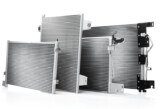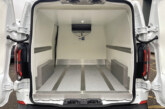
CVW hears how ZF engineers literally became test crash dummies in a bid to improve bus passenger safety.
Every driver who has suddenly had to hit the brakes while driving will know the impact of these forces on the body. While the occupants of a car can rely on seatbelts to help counter this forward momentum, what happens when it’s a city bus full of people? Unaware of the impending collision ahead, without seatbelts and many standing, passengers are left vulnerable.
“Coming to a sudden full stop might avoid a crash, but passengers can still get injured from falling over and bumping into each other,” explains Philipp Helmich, head of vehicle dynamics product lines with ZF’s commercial vehicle solutions division. “Using our experience and knowledge, we have developed a pioneering new collision mitigation system (CMS) for city buses. By connecting the radar and camera with a central processing unit and braking system, City bus CMS addresses the clear and pressing demand for ever-higher levels of safety in city traffic.”
Offering active braking to help avoid frontal collisions with other road users, including vehicles, bicycles and pedestrians, ZF’s city bus CMS system helps counter the adverse impact of braking momentum on passengers. Helping reduce the risk of accidents and injuries both inside and outside of the bus, ZF’s solution is the industry’s first manufacturer independent CMS specifically engineered for city bus applications.
Testing times
Balancing safety requirements was crucial to the development of City Bus CMS. The key question was how much braking force is necessary to maximise the chance of avoiding a crash while keeping occupants inside the bus safe? To figure this out, advanced driver assistance systems (ADAS) experts from ZF went above and beyond the usual testing protocols. At the company’s test track in Jeversen, Germany, the team strapped on safety harnesses and helmets on board a city bus. Testing, documenting and evaluating the experience at different speeds and braking forces from a passenger perspective helped to determine how much deceleration intensity is acceptable at a given speed.

“After that, we had to transfer these findings into algorithms for the system’s control software,” points out Jakob Schmidt, customer requirements engineer with ZF’s CVS division. “What we did was integrate the data with ZF’s advanced braking capabilities that are precisely calibrated to the vehicle’s speed and weight. That way, we achieve a seamless interaction between the ADAS and braking system.
“Braking pressure is carefully applied across the braking profile, making passengers far less likely to be jolted and put off-balance,” adds Schmidt. “Designing the breaking profile like that minimises the adverse effect on the passengers while still providing the best possible support for the bus driver in these challenging situations.”
Emergency braking assistance systems for city buses are not currently regulated and need a different approach to help safeguard passengers from injury during emergency braking. The complex and highly dynamic urban traffic environment also makes it difficult to implement. ZF’s solution tackles these issues head on. Signals from the sensing units are transmitted and calculated to make “intelligent” braking for the city bus possible. A slight brake easing after initial pressure helps give standing passengers the opportunity to hold on and prevent a fall before brake force is again increased.

Offering significant value for manufacturers and fleet customers, ZF claims its city bus CMS represents a major step forward in enhancing bus safety for passengers and road users alike. Helping mitigate hazardous traffic situations in the complexity of an urban environment requires sophisticated situational analysis, including advanced object detection and classification. Building on ZF’s safety systems expertise, the CMS draws on its latest OnGuardMAX technology with specific features and functionalities that are tailored to city bus applications.
Combining the data from its state-of-the-art camera and radar provides continuous analysis of the traffic situation. If an impending collision is detected, the system can issue a forward collision warning (FCW) and automatically apply the brakes to help mitigate or avoid an accident.
The system is compatible with both electric and internal combustion engines. Having already secured business wins from leading bus manufacturers, ZF will initially launch its city bus CMS in Europe and, ultimately, plans to roll the system out worldwide.









